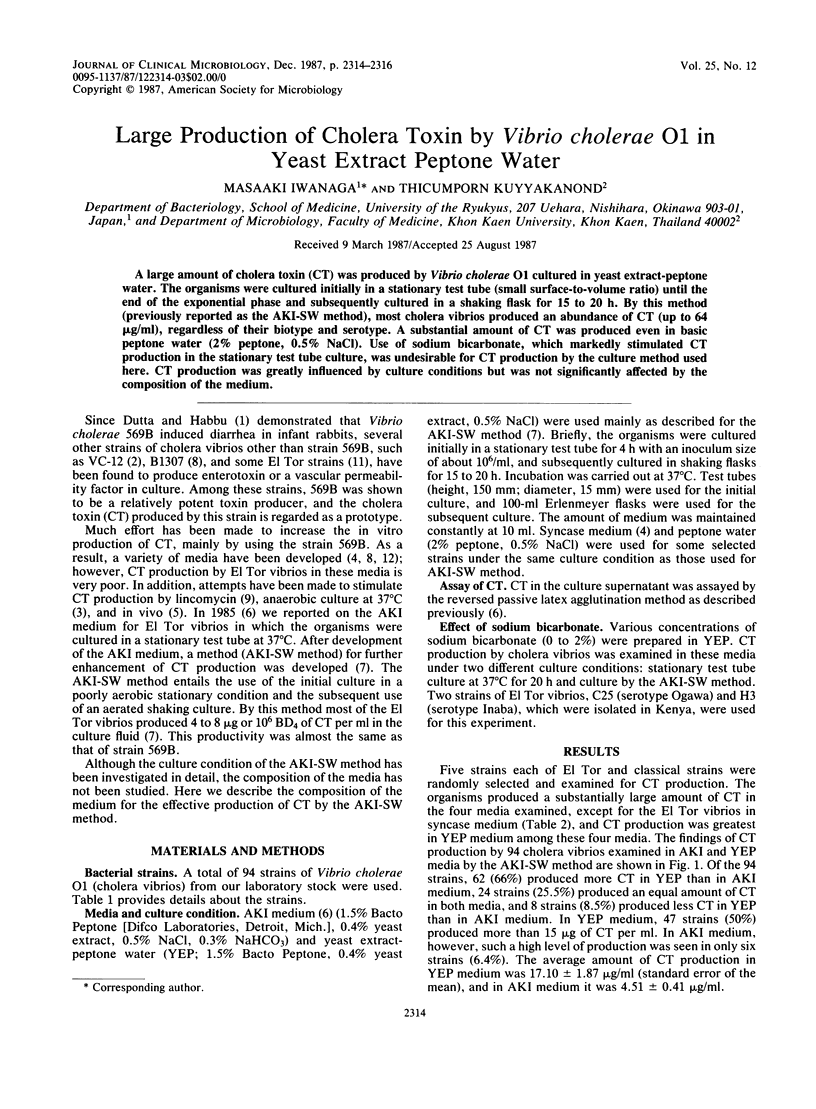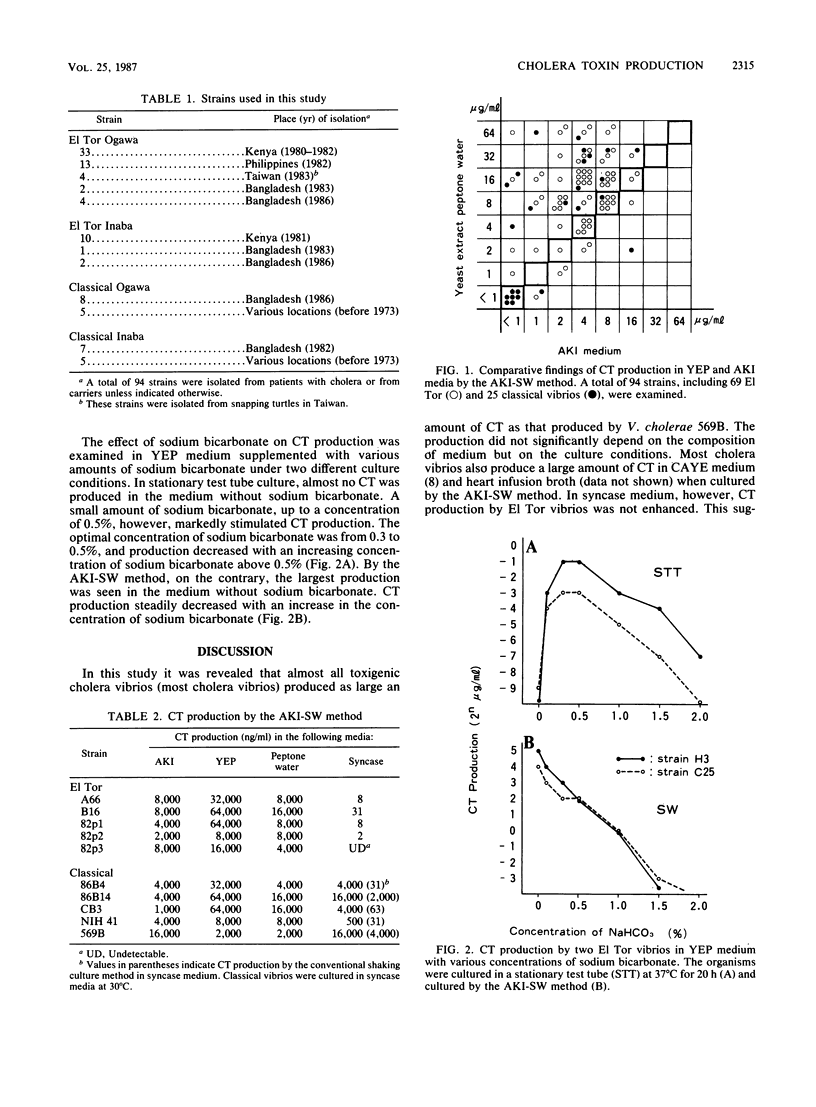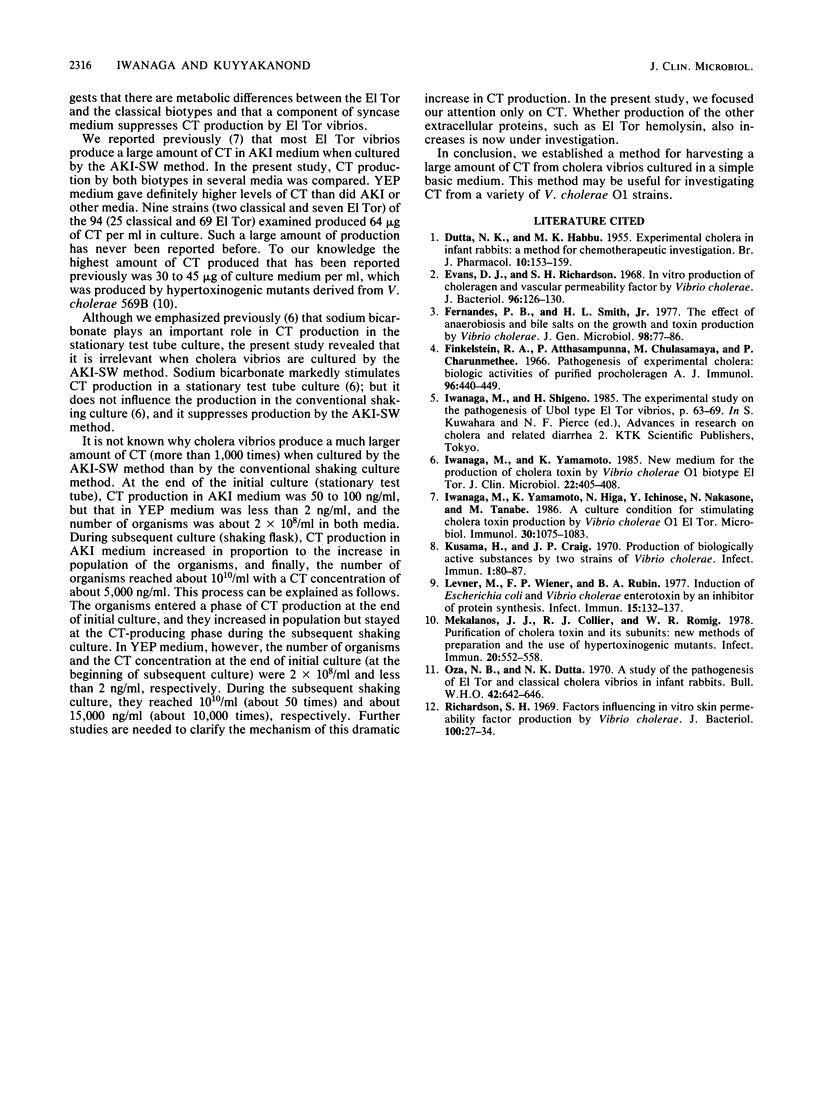Abstract
A large amount of cholera toxin (CT) was produced by Vibrio cholerae O1 cultured in yeast extract-peptone water. The organisms were cultured initially in a stationary test tube (small surface-to-volume ratio) until the end of the exponential phase and subsequently cultured in a shaking flask for 15 to 20 h. By this method (previously reported as the AKI-SW method), most cholera vibrios produced an abundance of CT (up to 64 micrograms/ml), regardless of their biotype and serotype. A substantial amount of CT was produced even in basic peptone water (2% peptone, 0.5% NaCl). Use of sodium bicarbonate, which markedly stimulated CT production in the stationary test tube culture, was undesirable for CT production by the culture method used here. CT production was greatly influenced by culture conditions but was not significantly affected by the composition of the medium.
Full text
PDF


Selected References
These references are in PubMed. This may not be the complete list of references from this article.
- DUTTA N. K., HABBU M. K. Experimental cholera in infant rabbits: a method for chemotherapeutic investigation. Br J Pharmacol Chemother. 1955 Jun;10(2):153–159. doi: 10.1111/j.1476-5381.1955.tb00074.x. [DOI] [PMC free article] [PubMed] [Google Scholar]
- Evans D. J., Jr, Richardson S. H. In vitro production of choleragen and vascular permeability factor by Vibrio cholerae. J Bacteriol. 1968 Jul;96(1):126–130. doi: 10.1128/jb.96.1.126-130.1968. [DOI] [PMC free article] [PubMed] [Google Scholar]
- Fernandes P. B., Smith H. L., Jr The effect of anaerobiosis and bile salts on the growth and toxin production by Vibrio cholerae. J Gen Microbiol. 1977 Jan;98(1):77–86. doi: 10.1099/00221287-98-1-77. [DOI] [PubMed] [Google Scholar]
- Finkelstein R. A., Atthasampunna P., Chulasamaya M., Charunmethee P. Pathogenesis of experimental cholera: biologic ativities of purified procholeragen A. J Immunol. 1966 Mar;96(3):440–449. [PubMed] [Google Scholar]
- Iwanaga M., Yamamoto K., Higa N., Ichinose Y., Nakasone N., Tanabe M. Culture conditions for stimulating cholera toxin production by Vibrio cholerae O1 El Tor. Microbiol Immunol. 1986;30(11):1075–1083. doi: 10.1111/j.1348-0421.1986.tb03037.x. [DOI] [PubMed] [Google Scholar]
- Iwanaga M., Yamamoto K. New medium for the production of cholera toxin by Vibrio cholerae O1 biotype El Tor. J Clin Microbiol. 1985 Sep;22(3):405–408. doi: 10.1128/jcm.22.3.405-408.1985. [DOI] [PMC free article] [PubMed] [Google Scholar]
- Kusama H., Craig J. P. Production of Biologically Active Substances by Two Strains of Vibrio cholerae. Infect Immun. 1970 Jan;1(1):80–87. doi: 10.1128/iai.1.1.80-87.1970. [DOI] [PMC free article] [PubMed] [Google Scholar]
- Levner M., Wiener F. P., Rubin B. A. Induction of Escherichia coli and Vibrio cholerae enterotoxins by an inhibitor of protein synthesis. Infect Immun. 1977 Jan;15(1):132–137. doi: 10.1128/iai.15.1.132-137.1977. [DOI] [PMC free article] [PubMed] [Google Scholar]
- Mekalanos J. J., Collier R. J., Romig W. R. Purification of cholera toxin and its subunits: new methods of preparation and the use of hypertoxinogenic mutants. Infect Immun. 1978 May;20(2):552–558. doi: 10.1128/iai.20.2.552-558.1978. [DOI] [PMC free article] [PubMed] [Google Scholar]
- Oza N. B., Dutta N. K. A study of the pathogenesis of El Tor and classical cholera vibrios in infant rabbits. Bull World Health Organ. 1970;42(4):642–646. [PMC free article] [PubMed] [Google Scholar]
- Richardson S. H. Factors influencing in vitro skin permeability factor production by Vibrio cholerae. J Bacteriol. 1969 Oct;100(1):27–34. doi: 10.1128/jb.100.1.27-34.1969. [DOI] [PMC free article] [PubMed] [Google Scholar]


